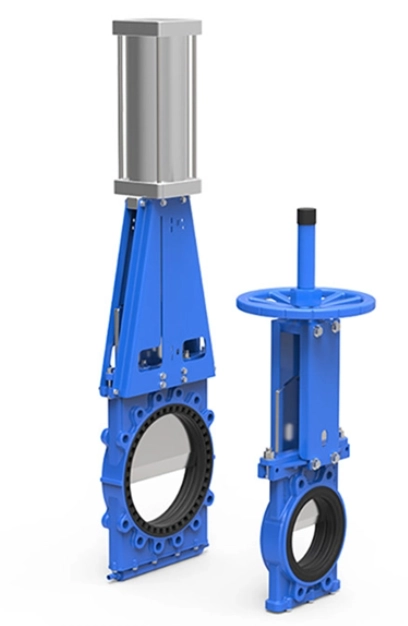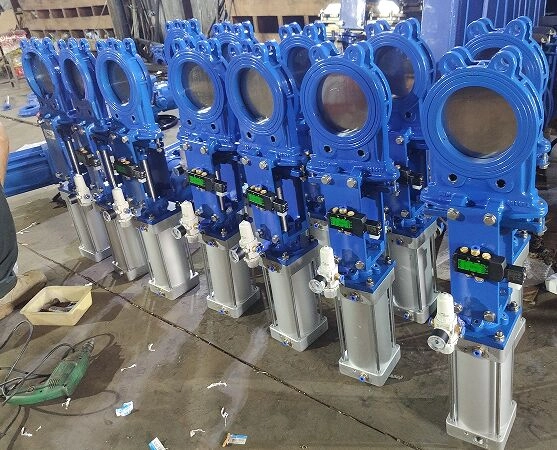close
Choose Your Site
Global
Social Media
Views: 0 Author: Site Editor Publish Time: 2025-07-01 Origin: Site











Ever wondered how industries manage to control thick liquids and slurries? Pneumatic knife gate valves play a key role in this process. But what exactly is a pneumatic knife gate valve? It’s a critical tool used in many industries for controlling the flow of tough materials. In this article, we’ll dive into how pneumatic knife gate valves work, their applications, and why they’re essential in various sectors.
A pneumatic knife gate valve is a special type of valve used to stop or allow the flow of thick materials like slurries, pulp, or wastewater. The standout feature is its blade-like gate that slices right through heavy media. Instead of turning a handle, this valve opens and closes using a pneumatic actuator. That means air pressure moves the gate up or down, fast and smoothly.
You will often see these valves in industrial settings where other valves would get clogged. They are built tough and made to work even in the dirtiest, most abrasive environments.
When compressed air enters the actuator, it pushes a piston that forces the knife-like gate to move. Here is how it works:
● Actuator moves the gate up and down using air pressure
● The sharp blade cuts through thick, heavy liquids
● A surrounding liquid helps reduce friction and protect the blade
The key is that sharp gate. It does not just block flow; it cuts through it.
The body and internal parts must handle tough jobs. Below is a table showing common materials and their pros and cons:
Material | Advantages | Disadvantages | Common Uses |
Stainless Steel | Corrosion-resistant, durable | Higher cost | Food, chemical, wastewater |
Carbon Steel | Strong, cost-effective | Prone to rust | Mining, oil and gas |
Cast Iron | Cheap, good for low-pressure systems | Brittle, can crack under impact | Water treatment |
Tougher than cast iron, better flexibility | Not as corrosion-resistant as stainless steel | Slurries, paper mills |
Each material has a purpose. Stainless is for harsh chemicals, while ductile iron handles shock better.
Pneumatic knife gate valves come in several designs. Each one fits a specific job:
● Conventional Knife Gate Valve: No extras. Best for general flow control in low-pressure systems
● Bonneted Valve: Comes with a protective cover. Great for high-pressure or dirty applications
● Through Conduit Valve: Allows more flow with less restriction
● Rising Stem Valve: You can see when it is open
● Non-Rising Stem Valve: Saves space where stem movement is limited
● Severe Service Valve: Built for extreme conditions like mining or chemical slurries
Choosing the right type saves time and prevents valve failure.
The valve seat and stem keep everything sealed and moving properly:
● Valve Seats: Create a seal between the blade and body
○ Metal Seats: Durable, good for hot fluids or abrasives
○ Resilient Seats: Softer, made of rubber or plastic, ideal for tight seals
● Valve Stems:
○ Rising Stem: Moves up when the valve opens, easier to monitor
○ Non-Rising Stem: The stem stays in place; the gate moves inside
A bad seat or bent stem means leaks or stuck valves. Regular checks help avoid that.

Pneumatic knife gate valves are widely used in industries where thick, solid-loaded fluids need to be controlled with precision. Their ability to cut through dense material and seal tightly makes them a top choice for many operations.
Here are some of the most common applications:
Industry | Why They Use It |
Pulp and Paper | These valves handle fibrous slurries without clogging. The sharp blade slices through pulp, ensuring smooth flow. |
Wastewater | Perfect for managing sludge and chemical waste. They resist corrosion and keep treatment plants running efficiently. |
Petroleum and Chemical | Can handle high temperatures, strong chemicals, and pressure variations. Ideal for aggressive fluid environments. |
Mining and Fertilizer | Work well in systems that move solids using air. The valve’s durability prevents wear from sand or abrasive media. |
You’ll also find these valves in cement plants, food factories, and power stations.
Wherever thick, sticky, or gritty flows exist, they perform reliably.
Industrial operations demand equipment that is strong, reliable, and easy to manage. Pneumatic knife gate valves meet all three needs. Here's why so many industries trust them:
● Handles difficult materials: They are built for tough jobs. Whether it’s pulp, mud, or slurry, the valve can handle it without jamming.
● Precise air-powered control: The pneumatic actuator opens and closes the valve quickly. This gives operators more control over the flow.
● Simple design: With fewer moving parts, there’s less that can go wrong. Maintenance becomes easier and quicker.
● Durable and long-lasting: These valves stand up to pressure, corrosion, and daily wear. They’re made to last in rough environments.
Even in extreme conditions, these valves rarely fail.
They’re an ideal choice for operations that require power and precision every day.

This is why these valves are a smart choice:
● High durability even in corrosive and high-pressure environments
● Reliable operation with fast actuation
● Simple to install and operate
● Available in many sizes and designs for different needs
They are great in places where other valves cannot survive.
Some limitations to keep in mind:
● Risk of water hammer if the valve closes too quickly
● Not good for adjusting flow rates unless specially designed for that
Use them for open or shut positions, not in between.
These are the most frequent issues:
● Leaky valve due to damaged seats or a worn blade
● Stuck gate because of debris or dried material
● Actuator problems from low air pressure or broken seals
Quick ways to spot and solve problems:
● Check for buildup on the gate edge
● Inspect actuator parts and air pressure supply
● Watch for slow or noisy movement as warning signs
Want your valve to last longer? Try this:
● Clean regularly to remove sludge or particles
● Lubricate the stem to stop rust and sticking
● Tighten bolts and connections to prevent air leaks
● Clear away grit that could damage the blade
● Replace old or cracked seals quickly
A little care now can prevent big repairs later.
Pneumatic knife gate valves handle thick liquids and solids with ease.They use air pressure to open and close smoothly.These valves are vital in pulp, mining, and wastewater industries. They resist wear, cut through tough flows, and are easy to maintain.Choose based on fluid type, pressure level, and environment.They offer reliable control where other valves may fail.
A: It uses a sharp blade to cut through thick slurries, unlike butterfly, ball, or check valves, which are not ideal for heavy solids.
A: It’s mainly for on/off control. Flow regulation is limited and should only be done with valves specifically designed for throttling.
A: Mining, wastewater treatment, pulp and paper, and chemical industries rely on them for handling abrasive or solid-laden fluids.
A: Match the valve to your system's material type, fluid temperature, pressure level, and flow conditions for best performance.